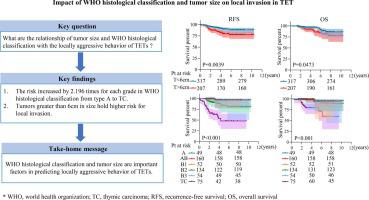Lung Cancer ( IF 5.3 ) Pub Date : 2023-12-16 , DOI: 10.1016/j.lungcan.2023.107446 Jian Gao , Yongqiang Ao , Shuai Wang , Zongwei Chen , Yi Zhang , Jianyong Ding , Jiahao Jiang

|
Objective
The aim of this study was to explore the influencing factors that affect the local invasive behavior of thymic epithelial tumors (TETs).
Method
We retrospectively analyzed 524 patients with TETs who underwent surgical treatment at our center from January 2010 to January 2022. Cox regression analysis was applied to identify predictors associated with the prognosis of TET. Logistic regression analysis was used to analyze the factors associated with the locally invasive behavior of TETs. Receiver operating characteristic analysis and the Youden index were applied to determine the predictive efficiency and cutoff value.
Results
There were 275 males and 249 females with a median age of 56 years. Seventy-seven patients had locally invasive behavior. The prognosis of local invasive TETs was significantly worse that of noninvasive TETs (P < 0.001). WHO classification and tumor size were two hazard factors for tumor invasive behavior. The risk of local invasion increased by 2.196 (OR (95 % CI): 1.813–2.659) times for each grade in WHO classification with a change from type A to thymic carcinoma. The tumor size cutoff of 6 cm represented a distinct boundary in predicting the hazard of local invasion (AUC: 0.784, specificity: 0.711, sensitivity: 0.726).
Conclusion
WHO classification and tumor size are important factors in predicting the locally aggressive behavior of TETs. The invasion capability of TETs is constantly increasing with an escalation in WHO classification. Tumors greater than 6 cm in size have a higher risk for local invasion.
中文翻译:

世界卫生组织组织学分类和肿瘤大小是胸腺上皮肿瘤局部侵袭行为的预测因子
客观的
本研究的目的是探讨影响胸腺上皮肿瘤(TETs)局部侵袭行为的影响因素。
方法
我们回顾性分析了 2010 年 1 月至 2022 年 1 月期间在我们中心接受手术治疗的 524 例 TET 患者。应用 Cox 回归分析来确定与 TET 预后相关的预测因素。采用Logistic回归分析分析与TET局部侵袭行为相关的因素。应用接受者操作特征分析和约登指数来确定预测效率和截止值。
结果
其中有 275 名男性和 249 名女性,中位年龄为 56 岁。七十七名患者有局部侵入行为。局部侵入性 TET 的预后明显差于非侵入性 TET(P < 0.001)。 WHO分类和肿瘤大小是肿瘤侵袭行为的两个危险因素。从 A 型变为胸腺癌,WHO 分类中每个级别的局部浸润风险增加 2.196(OR(95% CI):1.813–2.659)倍。 6 cm 的肿瘤大小截止值代表了预测局部侵袭风险的明显边界(AUC:0.784,特异性:0.711,敏感性:0.726)。
结论
WHO 分类和肿瘤大小是预测 TET 局部侵袭行为的重要因素。随着WHO分类的升级,TET的侵袭能力不断增强。大于 6 厘米的肿瘤局部侵袭的风险较高。



























 京公网安备 11010802027423号
京公网安备 11010802027423号